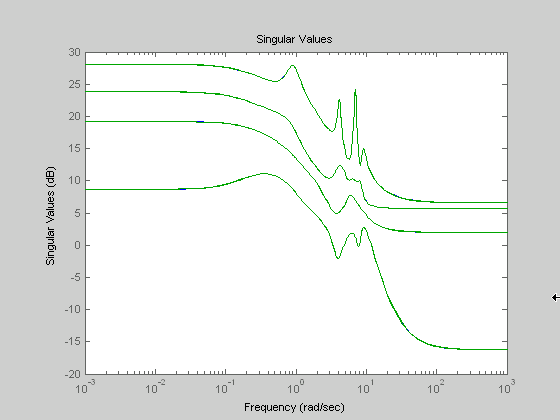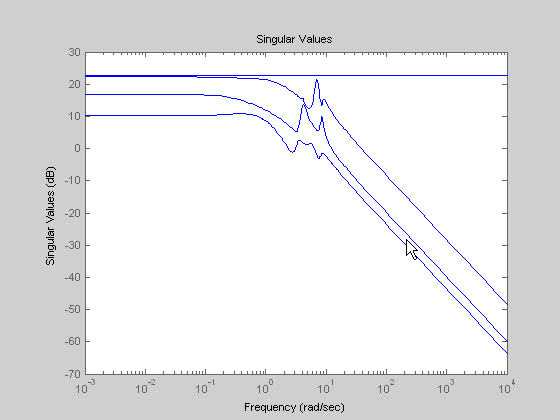hankelmr
(Not recommended) Hankel minimum degree approximation (MDA) without balancing
hankelmr is not recommended. Use
reducespec instead. (since R2023b) For more information on updating your
code, see Version History.
Syntax
GRED = hankelmr(G) GRED = hankelmr(G,order) [GRED,redinfo] = hankelmr(G,key1,value1,...) [GRED,redinfo] = hankelmr(G,order,key1,value1,...)
Description
hankelmr returns a reduced order model
GRED of G and a struct array
redinfo containing the error bound of the reduced model and
Hankel singular values of the original system.
The error bound is computed based on Hankel singular values of G. For a stable system Hankel
singular values indicate the respective state energy of the system. Hence, reduced order
can be directly determined by examining the system Hankel SV's,
σι.
With only one input argument G, the function will show a Hankel
singular value plot of the original model and prompt for model order number to
reduce.
This method guarantees an error bound on the infinity norm of the additive error ∥G-GRED∥ ∞ for
well-conditioned model reduced problems [1]:
Note
It seems this method is similar to the additive model reduction routines
balancmr and schurmr, but actually it can
produce more reliable reduced order model when the desired reduced model has nearly
controllable and/or observable states (has Hankel singular values close to machine
accuracy). hankelmr will then select an optimal reduced system to
satisfy the error bound criterion regardless the order one might naively select at
the beginning.
This table describes input arguments for hankelmr.
Argument | Description |
|---|---|
G | LTI model to be reduced (without any other inputs will plot its Hankel singular values and prompt for reduced order) |
ORDER | (Optional) an integer for the desired order of the reduced model, or optionally a vector packed with desired orders for batch runs |
A batch run of a serial of different reduced order models can be generated by
specifying order = x:y, or a vector of integers. By default, all the
anti-stable part of a system is kept, because from control stability point of view,
getting rid of unstable state(s) is dangerous to model a system.
'MaxError' can be
specified in the same fashion as an alternative for
'ORDER'. In this case, reduced order will be
determined when the sum of the tails of the Hankel sv's reaches the
'MaxError'.
Argument | Value | Description |
|---|---|---|
'MaxError' | Real number or vector of different errors | Reduce to achieve H∞ error. When present,
|
'Weights' |
| Optimal 1x2 cell array of LTI weights
|
'Display' |
| Display Hankel singular plots (default
|
'Order' | Integer, vector or cell array | Order of reduced model. Use only if not specified as 2nd argument. |
Weights on the original model input and/or output can make the model reduction algorithm focus on some frequency range of interests. But weights have to be stable, minimum phase and invertible.
This table describes output arguments.
Argument | Description |
|---|---|
GRED | LTI reduced order model. Become multi-dimensional array when input is a serial of different model order array. |
REDINFO | A STRUCT array with 4 fields:
|
G can be stable or unstable, continuous or discrete.
Note
If size(GRED) is not equal to the order you specified. The
optimal Hankel MDA algorithm has selected the best Minimum Degree Approximate it can
find within the allowable machine accuracy.
Examples
Given a continuous or discrete, stable or unstable system, G, the
following commands can get a set of reduced order models based on your
selections:
rng(1234,'twister'); G = rss(30,5,4); [g1, redinfo1] = hankelmr(G); % display Hankel SV plot % and prompt for order (try 15:20) [g2, redinfo2] = hankelmr(G,20); [g3, redinfo3] = hankelmr(G,[10:2:18]); [g4, redinfo4] = hankelmr(G,'MaxError',[0.01, 0.05]); for i = 1:4 figure(i); eval(['sigma(G,g' num2str(i) ');']); end
Singular Value Bode Plot of G (30-state, 5 outputs, 4 inputs) shows a
singular value Bode plot of a random system G with 20 states, 5
output and 4 inputs. The error system between G and its
Zeroth order Hankel MDA has it infinity norm equals to an all
pass function, as shown in All-Pass Error System Between G and Zeroth Order G Anticausal.
The Zeroth order Hankel MDA and its error system sigma plot are obtained via commands
[g0,redinfo0] = hankelmr(G,0); sigma(G-redinfo0.Ganticausal)
This interesting all-pass property is unique in Hankel MDA model reduction.
Singular Value Bode Plot of G (30-state, 5 outputs, 4 inputs)

All-Pass Error System Between G and Zeroth Order G Anticausal

Algorithms
Given a state-space (A,B,C,D) of a system and k, the desired reduced order, the following steps will produce a similarity transformation to truncate the original state-space system to the kth order reduced model.
Find the controllability and observability Gramians P and Q.
Form the descriptor
where , and descriptor state-space
Take SVD of descriptor E and partition the result into kth order truncation form
Apply the transformation to the descriptor state-space system above we have
Form the equivalent state-space model.
The final kth order Hankel MDA is the stable part of the above state-space realization. Its anticausal part is stored in
redinfo.Ganticausal.
The proof of the Hankel MDA algorithm can be found in [2]. The error system between the original system G and the Zeroth Order Hankel MDA G0 is an all-pass function [1].
References
[1] Glover, K., “All Optimal Hankel Norm Approximation of Linear Multivariable Systems, and Their L∝-error Bounds,” Int. J. Control, vol. 39, no. 6, pp. 1145-1193, 1984.
[2] Safonov, M.G., R.Y. Chiang, and D.J.N. Limebeer, “Optimal Hankel Model Reduction for Nonminimal Systems,” IEEE Trans. on Automat. Contr., vol. 35, no. 4, April 1990, pp. 496-502.